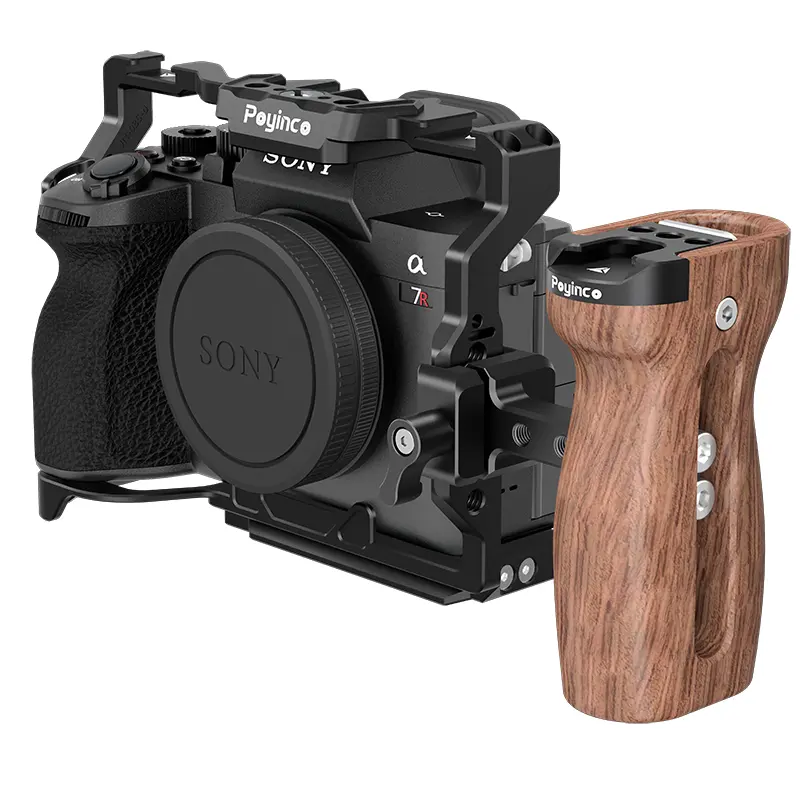

Time:2025-11-08 Views:1

A wear-resistant material camera handle is engineered using durable, abrasion-resistant materials to withstand long-term use, frequent contact, and harsh environmental conditions—addressing the common issue of handle degradation (e.g., surface scuffing, grip fading) faced by professional photographers and videographers. Unlike standard handles made from basic plastic or low-grade rubber (which show signs of wear after 3-6 months of heavy use), these handles use advanced materials that maintain structural integrity and grip performance for 2-3 years, making them ideal for high-frequency use scenarios (e.g., rental equipment, daily studio shoots, outdoor adventures).
The key to a wear-resistant camera handle lies in its material selection and surface treatment, with three primary material categories dominating the market: 1) Reinforced Polymer Composites: These materials combine base polymers with reinforcing fibers to enhance abrasion resistance. For example: - Glass Fiber-Reinforced Nylon: Nylon blended with 20-30% glass fiber has a Taber abrasion index (a measure of wear resistance) of <50mg loss per 1000 cycles (compared to >200mg for standard nylon). Handles like the SmallRig Universal Camera Handle use this material for the core structure, ensuring resistance to scratches from gear bags, tripod legs, and outdoor debris. - Carbon Fiber-Reinforced Polycarbonate: Carbon fiber adds not only strength but also wear resistance—this composite resists surface scuffing even when rubbed against rough surfaces like concrete or rock. The Peak Design Carbon Fiber Camera Handle, for instance, retains its smooth finish after repeated contact with outdoor gear, making it a top choice for wildlife photographers. 2) High-Density Elastomers: For grip surfaces, wear-resistant elastomers (e.g., thermoplastic rubber, TPR) with high Shore hardness (60-70 Shore A) are used. These materials differ from standard rubber in two key ways: - Cross-Linked Molecular Structure: The elastomer molecules are chemically cross-linked, creating a dense network that resists friction-induced wear. This means the grip won’t develop “shiny spots” or lose texture even after thousands of hours of hand contact. - Oil and Chemical Resistance: They repel camera cleaning solutions, sweat, and outdoor contaminants (e.g., dirt, saltwater), preventing material breakdown. The Sony VG-C6EM Vertical Grip uses this type of elastomer for its grip, maintaining traction even for photographers with oily skin or those shooting in humid environments. 3) Metal Alloys with Protective Coatings: For premium metal handles, a base of aluminum or magnesium alloy is paired with a hard protective coating: - Anodized Aluminum: Anodization creates a 5-10μm thick oxide layer on the aluminum surface, with a Mohs hardness rating of 5-6 (compared to 2.5 for uncoated aluminum). This coating resists scratches from metal objects (e.g., lens caps, tripod screws) and prevents oxidation. The Fujifilm MHG-XH2 Metal Hand Grip uses Type III anodization (the thickest anodized layer) for maximum wear resistance. - PVD-Coated Magnesium Alloy: Physical Vapor Deposition (PVD) applies a thin layer of titanium nitride or chromium to magnesium alloy, creating a surface that is both scratch-resistant and corrosion-proof. This coating is commonly used in professional cinema camera handles (e.g., RED Komodo Handle), where durability and aesthetics are equally important.
Real-world testing confirms the longevity of these materials: a rental company reported that wear-resistant handles required 70% fewer replacements over a 2-year period compared to standard handles, reducing maintenance costs significantly. For users who prioritize long-term value, a wear-resistant camera handle is an investment that avoids the frustration of frequent replacements and ensures consistent grip performance in every shooting scenario.
Read recommendations:
Camera Cage for Canon EOS M50 M50 Mark II Camera Aluminum Alloy Video Film Movie Making Rig
motorcycle camera mount kit price